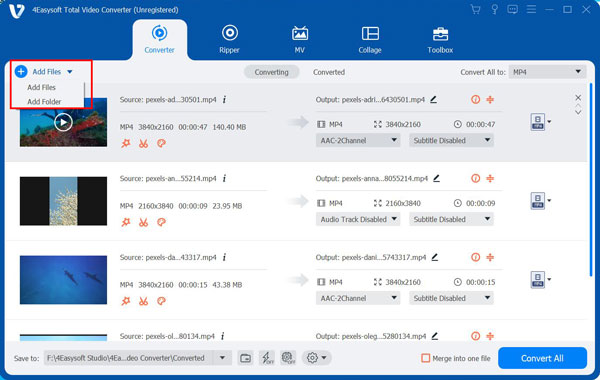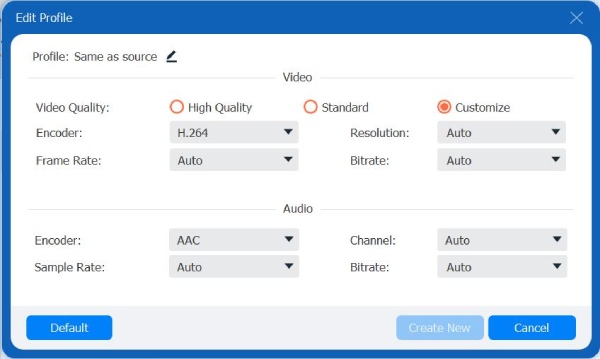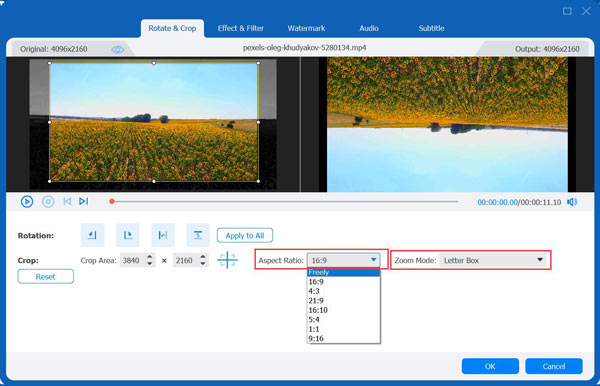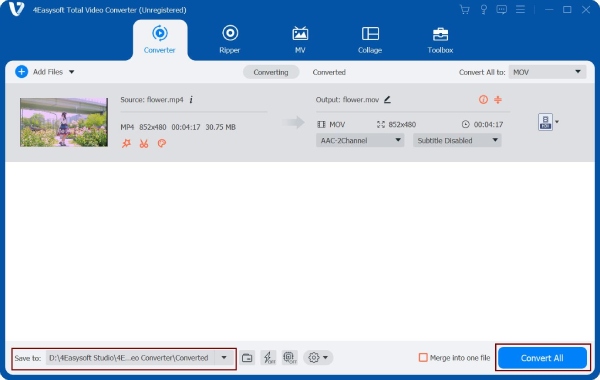Convert, edit, and compress videos/audios in 1000+ formats with high quality.
The Ultimate Guide About YouTube Video Size You Must Explore
Considering the imposed YouTube video sizes, like dimensions, resolutions, and other aspects, while editing, will help prevent your video’s quality from being reduced. If your video doesn’t perfectly match YouTube’s specifications, you will most likely encounter issues with how it appears as a post or uploading it. Thankfully, this article features a comprehensive YouTube video size guide that will help you ensure your videos look best! Get to know them below.
Guide List
The Best YouTube Video Resolution, Dimension, & Aspect Ratio Best Video File Formats for YouTube Uploads YouTube’s Supported Video Length and File Size Limits Preferred YouTube Thumbnail Size Specification for Best Results Exploring Video Standards for Other YouTube Video Uploads The Easy Way to Resize Videos with High Quality for YouTube UploadThe Best YouTube Video Resolution, Dimension, & Aspect Ratio
The first YouTube video size guide this post would like to share is the platform’s-imposed video resolution, dimension, and aspect ratio. Knowing YouTube’s size specification will help prevent your video from having black bars and unexpected cropping right after you upload. With the correct sizes, you can easily make your video look crisp and professional within YouTube’s platform across different devices. What is the YouTube video size in terms of resolution, dimension, and aspect ratio? Explore the table below.
| Resolution | Dimension Specification | Supported Aspect Ratio | Equivalent Quality |
| 8K | 7680 x 4320 | 16:9 | Ultra HD |
| 4K | 3840 x 2160 | 16:9 | Ultra HD |
| 1440p | 2560 x 1440 | 16:9 | QHD |
| 1080p | 1920 x 1080 | 16:9 | High Definition |
| 720p | 1280 x 720 | 16:9 | Supports Standard Definition or SD |
| 480p | 854 x 480 | 16:9 | Supports Standard Definition or SD |
| 360p | 640 x 360 | 16:9 | Lower video quality |
| 240p | 426 x 240 | 16:9 | Lowest video quality |
Those are the YouTube video size-supported resolutions, dimensions, aspect ratios, and video quality. As you can see, each size element plays an essential role in how your video appears on different devices and platforms.
Resolution and Dimension are significant factors for your video’s clarity; the higher resolutions, like 8K and 4K, offer more essential details. On the other hand, those videos with lower resolutions, such as 480p, 360p, and 240p, support a reduced level of sharpness since they are compressed.
Now, if you are asking which of these resolutions is the best to pick, there is no recommended resolution in particular. Why? Because even though your video is in 4K resolution, YouTube might lower the quality if the viewer’s or audience’s internet connection is slow. However, recording your videos in at least 720p for desktop viewing and 480p for mobile/smartphones will be better. If you wish to go beyond that, 1080p resolution is preferable across all devices.
In terms of Aspect Ratio, it determines how your video fits on various devices’ screens. The standard or default aspect ratio that YouTube supports is 16:9. If your video supports a different ratio other than the default, YouTube will automatically apply black bars or crop it to make it fit.
Best Video File Formats for YouTube Uploads
Aside from YouTube video dimension size , resolution, and aspect ratio, the platform also imposed specifications about file formats. Unlike the earlier specification, video formats act as rules determining how the video is stored and what platforms and devices can play it. YouTube’s preferred format is MP4 with H.264, AAC-LC, 96 kHz or 48 kHz audio bitrate, and 30 or 60 fps. This format provides an outstanding balance between quality and file size. Additionally, it is also widely supported across various platforms and devices. Other than MP4, here are the other video formats that the platform also supports: MOV, MPG, WMV, AVI, FLV, WebM, 3GPP, HEVC, DNxHR, CineForm, ProRes, and more.
YouTube’s Supported Video Length and File Size Limits
Apart from those size and file format specifications, you should also know that the best video size for YouTube is 256 GB, with up to 12 hours of length for verified accounts and 15 minutes for unverified. Now, you should also remember that although the platform allows you to upload a video with 256 GB of file size, it doesn’t mean you should. Why? This is because uploading a video with a 256 GB file size will take a longer upload and processing time. Moreover, it will take up a lot of storage space on your device and require a faster and more stable internet connection to upload smoothly.
Preferred YouTube Thumbnail Size Specification for Best Results
Besides the above specification, you must also know the YouTube video thumbnail size specification. First of all, a YouTube thumbnail is a small and clickable image that previews the content of your video. For you to gain views, your thumbnail should be eye-catching to attract viewers and encourage them to watch your video. The ideal dimensions are 1280x720, with a 16:9 aspect ratio. These specifications will ensure your thumbnail is clear and clickable.
Exploring Video Standards for Other YouTube Video Uploads
That’s it! Those are the YouTube video size specifications you must remember when editing a video. Other than the specifications for uploading videos on YouTube, here are the other standards to consider for adequately uploading YouTube Shorts and Ads.
Specifications of Shorts:
• Aspect Ratio – Since Shorts are designed to be played in a vertical orientation, the aspect ratio should be 9:16. You can also use 1:1 for videos shot in square frames.
• Resolution & Dimension – Although YouTube doesn’t impose a specific specification for resolution and dimension, a minimum of 480p and a maximum of 1080p would be the best options. These standards come with 1080x1920, 720x1280, and 480x854 dimensions.
• Video Length & Size – 60 seconds long with 256 GB file size.
• Video Format – MP4 is the preferred format.
Standards of Ads:
• Aspect Ratio – The platform’s recommended ad ratios are 1:1, 9:16, and 16:9.
• Resolution & Dimension – Ads should support a minimum of 720p to a maximum of 1080p resolution with these dimensions: 1920 x 1080px and 1280 x 720px for horizontal orientation, 1080 x 1920px and 720 x 1280px for vertical, and 1080 x 1080px and 480 x 480px for square.
• Video Format & File Size – Supports the same list of video formats featured earlier, with a 256 GB file size.
The Easy Way to Resize Videos with High Quality for YouTube Upload
There you go! That’s the comprehensive guide about YouTube video size specifications! Now, if your video doesn’t fall within those specifications and you wish to crop, compress, and trim them with high quality, the professional 4Easysoft Total Video Converter is a solid choice! This Mac and Windows-compatible tool supports easy-to-use yet effective video features that enable you to redefine your video based on YouTube’s specifications. It supports options to trim your video to shorten its length, crop it based on a specific aspect ratio, and compress it by lowering resolution and bitrate without losing quality. Moreover, it is also infused with various formats to convert your video if stored in a format YouTube does not recommend.

Support a trimmer feature that enables you to cut off unwanted areas of your video.
Let you convert your video to YouTube-supported video and audio codec and bitrate.
Equipped with other options to redefine your video: adding filters, effects, subtitles, etc.
Infused with real-time preview to check the changes you’ve made with your video.
100% Secure
100% Secure
Step 1Install the 4Easysoft Total Video Converter on your computer, and once you're done, you can launch it immediately. Then, click “Add Files” in the upper right corner, select the video you wish to edit based on YouTube video size specifications, and click “Open” to import it.

Step 2To compress or change the video’s format, click the “Convert All to” dropdown button, click “Video”, and select “MP4”. Then, click “Custom Profile”, lower the resolution by one step, adjust the bitrate according to YouTube’s recommendations, and click “Create New.

Step 3Regarding changing the video’s size, like aspect ratio, return to the tool’s main interface and click the “Edit” button with the “Starwand” icon. Then, you can change the aspect ratio under the “Rotate & Crop” section, click “Aspect Ratio” and select “16:9”. Pick “9:16” if it is for Shorts upload. After that, click “OK”.

Step 4If you finish the above setups, click “Convert All” at the lower right corner of the tool to start converting, processing, and saving the video on your computer’s local storage. And that’s how you use this tool to redefine your video based on YouTube video size specifications.

Conclusion
With those YouTube video size standards in mind, you can effectively prevent your videos from experiencing various effects due to mismatched aspects. This guide can help you properly edit your video to align with YouTube’s video size requirements. If you have a video that doesn’t match YouTube’s standards, you can use the professional 4Easysoft Total Video Converter tool to redefine it! With this tool’s editing features, you can efficiently and effectively fix your video based on the platform’s video specifications! Try using this tool today.
100% Secure
100% Secure



